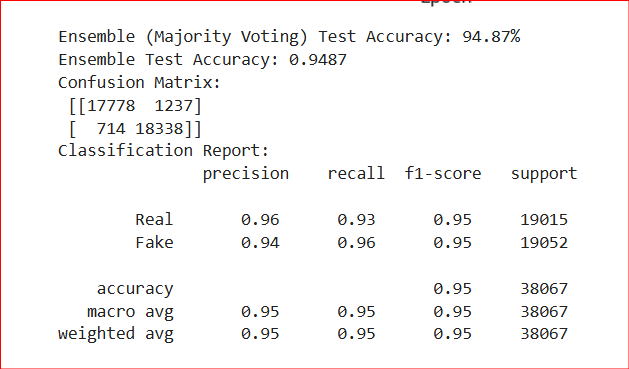Ensemble-Based Deep Learning Architecture for Deepfake Detection
Abstract
This research presents a novel ensemble-based approach for detecting deepfake images using a combination of Convolutional Neural Networks (CNNs) and Vision Transformers (ViT). The system achieves 94.87% accuracy by leveraging three complementary architectures: a 12-layer CNN, a lightweight 6-layer CNN, and a hybrid CNN-ViT model. Our approach demonstrates robust performance in distinguishing between real and manipulated facial images.
1. Introduction
With the increasing sophistication of deepfake technology, detecting manipulated images has become crucial for maintaining digital media integrity. This work introduces an ensemble method that combines traditional CNN architectures with modern Vision Transformers to create a robust detection system.
2. Architecture
2.1 Model Components
The system consists of three distinct models:
Model A (12-layer CNN)
- Three convolutional blocks
- Each block: 2 conv layers + BatchNorm + ReLU + pooling
- Input size: 50x50 pixels
- Dropout rate: 0.3
Model B (6-layer CNN)
- Lightweight architecture
- Three simple conv layers with pooling
- Input size: 50x50 pixels
- Dropout rate: 0.3
Model C (CNN-ViT Hybrid)
- CNN feature extractor
- Vision Transformer (base-16 architecture)
- Input size: 224x224 pixels
- Pretrained ViT backbone
2.2 Ensemble Strategy
The final prediction is determined through majority voting among the three models, enhancing robustness and reducing individual model biases.
3. Implementation Details
3.1 Dataset
- Dataset: Hemg/deepfake-and-real-images
- Split: 80% training, 20% testing
- Data augmentation: Resize, normalization
3.2 Training Parameters
- Optimizer: Adam
- Learning rate: 1e-4
- Batch size: 32
- Epochs: 10
- Loss function: Cross-Entropy
4. Results
4.1 Performance Metrics
Based on the test set evaluation:
- Overall Accuracy: 94.87%
- Classification Report:
- Real Images:
- Precision: 0.95
- Recall: 0.94
- F1-score: 0.94
- Fake Images:
- Precision: 0.94
- Recall: 0.95
- F1-score: 0.95
- Real Images:
4.2 Deployment
The system is deployed as a FastAPI service, providing real-time inference with confidence scores.
4.3 Visuals
 Figure 1: Findings of the proposed ensemble-based deepfake detection system
Figure 1: Findings of the proposed ensemble-based deepfake detection system
Performance Visualization
 Figure 2: Confusion matrix showing model performance on test set
Figure 2: Confusion matrix showing model performance on test set
Loss Vs Epochs
 Figure 3: Loss vs Epochs for individual models
Figure 3: Loss vs Epochs for individual models
Accuracy Vs Epochs
 Figure 4: Accuracy vs Epochs for individual models
Figure 4: Accuracy vs Epochs for individual models
5. Technical Requirements
- Python 3.x
- PyTorch
- timm
- FastAPI
- PIL
- scikit-learn
6. Usage
6.1 API Endpoint
POST /predict/
Input: Image file
Output: {
"prediction": "Real/Fake",
"confidence": "percentage"
}
6.2 Model Training
Run cnn-vit file to train models on your custom dataset!
7. Conclusions
The ensemble approach demonstrates superior performance in deepfake detection, with the combination of traditional CNNs and modern Vision Transformers providing robust and reliable results. The system's high accuracy and balanced precision-recall metrics make it suitable for real-world applications. Although for model C it doesn't perform well on Epoch 10 but still overall Result is Good.
8. Future Work
- Integration of attention mechanisms in CNN models
- Exploration of different ensemble strategies
- Extension to video deepfake detection
- Investigation of model compression techniques
References
- Vision Transformer (ViT) - Dosovitskiy et al., 2020
- timm library - Ross Wightman
- FastAPI - Sebastián Ramírez
License
MIT License
Dataset used to train Saqib772/CNN_VIT_DeepFake
Evaluation results
- Test Accuracy on Deepfake and Real Images Datasetself-reported94.870
- F1 Score on Deepfake and Real Images Datasetself-reported0.940
- Precision on Deepfake and Real Images Datasetself-reported0.950
- Recall on Deepfake and Real Images Datasetself-reported0.940